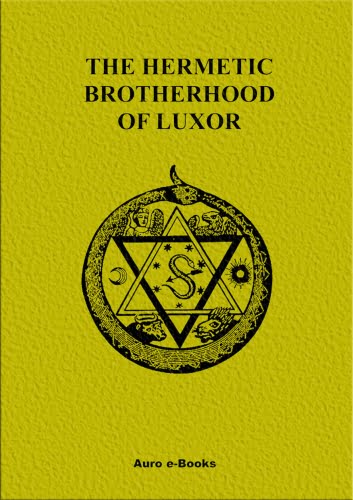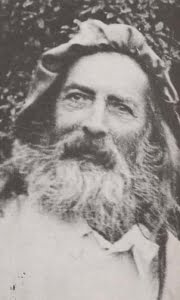The Hermetic Brotherhood of Luxor

The Hermetic Brotherhood of Luxor
This work is a scholarly investigation of the origins and activities of The Hermetic Brotherhood of Luxor. Of particular interest to the followers and admirers of Sri Aurobindo and The Mother is the light this work brings to the life and activities of the mysterious Max Theon, an occultist who had a great influence on The Mother in her early years. The following was taken from the book’s preface:
The Hermetic Brotherhood of Luxor was an order of practical occultism, active in the last decades of the 19th century. It taught its members how to lead a way of life most favorable to spiritual development, and gave them detailed instructions in how to cultivate occult powers by working on their own. It differed from contemporary movements such as the Theosophical Society (founded 1875), whose teachings (at least after its earliest phase) were philosophical rather than practical, and the Hermetic Order of the Golden Dawn (founded 1888), whose activities were social and ceremonial.
The “H. B. of L.” (as it was always known) succeeded in enrolling a surprising number of influential people, who carried forward its training and its doctrines into many other esoteric movements of the 20th century. Its private and individual nature, and the mystery that still partially surrounds its Grand Master Max Theon, are among the reasons why it has remained so obscure. Writers on the history of the Theosophical movement dismiss the H. B. of L.; Golden Dawn scholars ignore it. Most of the information available up to now comes from inadequate or untrustworthy sources.
We hope to have remedied the situation with this dossier, which has been compiled from a scholarly point of view and in the interests of intellectual history. Part 1 gives an account of the H. B. of L., its principal characters, its relationship to other groups, and its doctrines. Part 2 presents (where available) the original English texts of the manuscript instructions that were circulated to the membership. Part 3 is a historical dossier, comprising some fifty items that illustrate the changing fortunes of the Brotherhood, its internal affairs, and especially its conflict with the Theosophical Society. With this material now made available, the importance of the H. B. of L. will no longer be in question, and future studies of it can be conducted on a firm documentary basis.
Book Details
Author: Joscelyn Godwin, Christian Chanel, John P. Deveney
Print Length: 478
Publisher: Samuel Weiser, Inc.
Original source: http://www.kheper.net/topics/Hermeticism/HBoL.html
Contributor: Blindshiva
Book format: Pdf, ePub, Mobi
Language: English
Book Download
Contents
- Preface
- A Note on Sources
- ACKNOWLEDGMENTS
PART I. AN ORDER OF PRACTICAL OCCULTISM
- First Public Appearance of the H. B. of L.
- The Question Of Origins
- Identity of Max Theon
- Theon’s early activities
- Theon and the H. B. of L.
- Peter Davidson in Scotland
- Peter Davidson in America
- Thomas H. Burgoyne
- Paschal Beverly Randolph
- The Secret Documents
- Metaphysics of the H.B. of L.
- The H.B. of L. and Theosophical Doctrine
- Emma Hardinge Britten and the “Hidden Hand”
- Influence of the H. B. of L.
- The Practical Magic of the H. B. of L.
PART II. THE SECRET MANUSCRIPTS
- Introduction To The Secret Manuscripts of the H. B. of L.
- “To Whom It May Concern” (A.l.a)
- “The Ancient and Noble Order” (A.l.b)
- “Origin and Object of the H. B. of L.” (A.l.c)
- “List of Questions to be put to Neophytes” (A.l.d)
- “Hermetic Ritual for Private Initiation” (A.l.e)
- “The Rites and Ceremony for Exterior Initiation” (A.l.f)
- “Symbolical Notes to First Degree” (A.2.a)
- “The Hermetic Key” (A.2.b)
- “The Key” (A.2.c)
- “Naronia” (A.2.d)
- “Reincarnation” (A.2.e)
- “Laws of Magic Mirrors” (A.3.a)
- “The Mysteries of Eros” (A.3.b)
PART III. THE HISTORY OF THE H. B. OF L. IN DOCUMENTS
- Precursors of the H. B. of L. (B.l)
- Olcott Discovers the Brotherhood of Luxor (B.l.b)
- Mackenzie’s Definitions (B.l.c)
- Blavatsky Defines the Brotherhood of Luxor (B.l.d)
- Max Theon (B.2)
- Theon Advertised as Psychic Healer (B.2.b)
- Theon on the Origins of the H. B. of L. (B.2.c)
- The Launching of the H. B. of L. and the Occult Magazine (B.3)
- The First Advertisement (B.3.b)
- The Seer Becomes The Occultist (B.3.c)
- The Occultist Becomes The Occult Magazine (B.3.d)
- A Page from The Occult Magazine (B.3.e)
- The Seer Makes its Excuses
- The Colony (B.4)
- An Enquiry and an Answer (B.4.b)
- More Promises (B.4.c)
- The Principals Move to America (B.4.d)
- Some Clairifications (B.4.e)
- Davidson’s Budget (B.4.f)
- The “Colony” Established (B.4.g)
- The Polemic with the Theosophical Society (B.5)
- Judge Utters a Warning (B.5.b)
- The H. B. of L. Defines Itself (B.5.c)
- The H. B. of L. Defines the Theosophical Society (B.5.d)
- An Apology (B.5.e)
- A Peace Offer (B.5.f)
- The H. B. of L. Beyond East and West (B.5.g)
- A Peace Offer Rejected (B.5.h)
- Blavatsky’s Suspicions (B.5.j)
- Discovery of Burgoyne’s Conviction By The Theosophists (B.6)
- Ayton Identifies Burgoyne (B.6.b)
- Frauds and Black Magic (B.6.C.)
- Burgoyne’s Conviction (B.6.d)
- Burgoyne’s Police Record (B.6.e)
- Ayton’s Experiences (B.6.f)
- Fryar Dissociates Himself (B.6.g)
- A Warning and a Threat (B.6.h)
- Chintamon Again? (B.6.j)
- Blake Tries to Summarize the Affair (B.6.k)
- Another Summary of the Affair (B.6.l)
- Blavatsky’s Last Word on the Affair (B.6.m)
- Olcott’s Version of the Affair (B.6.n)
- The H. B. of L. in America and France (B.7)
- Burgoyne Answers an Enquirer (B.7.b)
- Johnson Answers an Enquirer (B.7.c)
- Barlet Answers an Enquirer (B.7.d)
- Davidson Counsels a Neophyte (B.7.e)
- Papus Publicizes the H. B. of L. (B.7.f)
- Barlet’s Summary of the H. B. of L.’s History (B.7.g)
- Chintamon Yet Again (B.7.h)
- Reactions to The Light of Egypt (B.8)
- P. Blavatsky (B.8.b)
- Anonymous Theosophist (B.8.c)
- R. S. Mead (B.8.d)
- Emma Hardinge Britten (B.8.e)
- Post-mortem debates (B.9)
- Waite’s Summary of the Affair (B.9.b)
- Barlet and Initiatic Societies (B.9.c)
- Some Corrections (B.9.d)
- Guénon Tells All (B.9.e)
Sample
The Hermetic Brotherhood of Luxor
The H. B. of L. first came to notice in the latter part of 1884, when a discreet advertisement appeared in an English edition of The Divine Pymander of Hermes Mercurius Trismegistus. It invited aspirants to contact a mysterious personage called Theosi or Theon, in the care of the publisher or an American agent [see items A.l.a and B.3.b in this dossier]. The curious would-be occultist would then receive a letter from an individual acting on the “Grand Master’s” behalf, asking for a photograph and a natal horoscope, so that it might be seen whether he or she was suited for occultism. Failing that, the aspirant was to send the necessary information for drawing up a horoscope, together with a small fee for the service [see B.7.a,c], No list of members survives, but we know that some applicants were rejected, which lends at least an appearance of good faith to an organization that was frequently dismissed by its enemies as a money-making fraud. While most European members were men, women predominated in America.
Those who were accepted as neophytes received in due course their initiatic materials: pledges, questionnaires, and the revelation of the H. B. of L.’s true name and degrees. The name was given on a slip of paper that was to be burned after reading. After a delay sometimes amounting to years, the rituals for self-initiation were disclosed [A.l.e].
Théon and his knowledge is truely extraordinary. At the very least he was, and is, equal in importance in understanding the development of modern Western esotericism, to figures such as Blavatsky, Steiner, Crowley, Gurdjieff, and Alice Bailey. Yet this figure, who was active in Paris around the turn of the century (he apparently commuted between Algeria and Paris), has been until only very recently virtually unknown outside the Mother and Sri Aurobindo’s talks! Now however the situation is changing, and hermetic scholars like Amazon com Christian Chanel and external link T Allen Greenfield have written on this important figure. (Read more on www.kheper.net)About Author: Ernest Becker
 Théon was in many ways a latter-day Gnostic, an enigmatic occultist whose evolutionary and occult teachings were indirectly taken up by the Indian philosopher-sage Sri Aurobindo, and may have also had some influence on the metaphysics of both H.P. Blavatsky and, A Polish Jew, he travelled to London, France, Egypt, and finally Algeria, founding several esoteric groups along the way. He was known under several names, but we can refer to him as “Max Théon”, the pseudonym he adopted while in Algeria.
Théon was in many ways a latter-day Gnostic, an enigmatic occultist whose evolutionary and occult teachings were indirectly taken up by the Indian philosopher-sage Sri Aurobindo, and may have also had some influence on the metaphysics of both H.P. Blavatsky and, A Polish Jew, he travelled to London, France, Egypt, and finally Algeria, founding several esoteric groups along the way. He was known under several names, but we can refer to him as “Max Théon”, the pseudonym he adopted while in Algeria.

Leave a Reply
Want to join the discussion?Feel free to contribute!